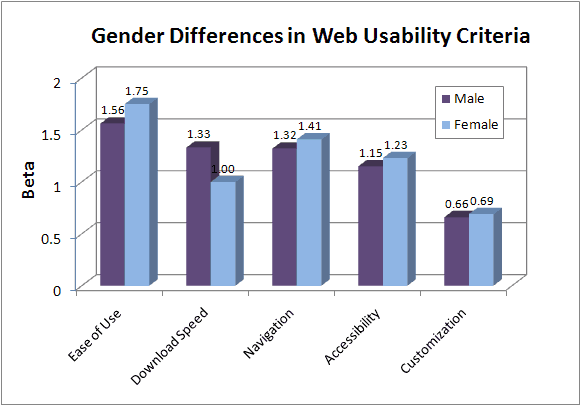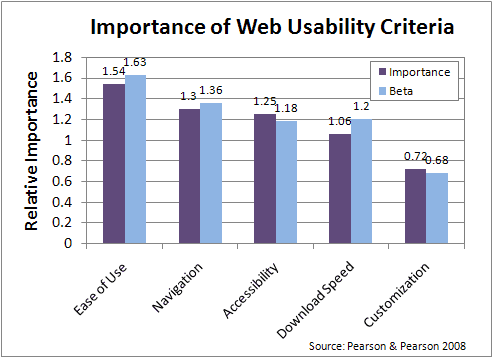The importance of download speed, for most Web users, has long been established (King 2008). Fast response times foster higher flow states (Skadberg & Kimmel 2004), higher conversion rates (Akamai 2007), higher perceived trustworthiness (Nielsen 1999), and lower user frustration (Ceaparu et al. 2004). But, previous research has also found that differences in gender, age and computer self-efficacy can moderate user priorities. This article explores the differences among men and women in their desire for speed.
Gender Differences in Website Usability Criteria
In a survey of 301 undergraduates on the importance of different web usability criteria, researchers from Southern Illinois University found that after ease of use, men prefer fast download speed over easy navigation (Pearson & Pearson 2008). Women prefer ease of use, easy navigation, and accessibility. Figure 1 shows the differences among genders for the most important factors in assessing web usability.
Figure 1: Gender Differences in Web Usability Criteria

Not surprisingly, both genders agree that ease of use is the most important factor in assessing website usability (beta of 1.56-1.75). It is in the second-most important factor that gender differences come into play. Men prefer fast download speeds second (1.33), while women prefer easy navigation (1.41). Customization was found to be the least important factor in web usability (0.66-0.69), consistent with a previous design factors research.
Reasons for Gender Differences in Web Usability Criteria
The researchers hypothesize that these gender differences are due to the fact that women use the Web to develop relationships while men use the Web for information gathering. Fast download speeds make searching for information online more efficient.
Relative Importance of Web Usability Criteria
Among all respondents, ease of use was found to be the most important factor in evaluating website usability (1.54 relative importance). Intuitive navigation was second at 1.3, while accessibility came in third at 1.25. Download speed came in fourth at 1.06 and customization/personalization came in last (0.72 relative importance). Customization was less than half as important as ease of use in evaluating website usability.
Figure 2: Relative Importance of Web Usability Criteria

Brief Interview with John Pearson
We asked one of the authors of the study about betas and what surpised them the most about their results.
“Beta weights are
used to determine the relative importance i.e. stronger betas
(higher values) would indicate that the decision maker places more
emphasis on that criteria (relative importance) – weaker betas
(lower values) would indicate that the decision maker does not
consider that criteria important in the decision making process.The thing I found most surprising was the relative lack of
importance the respondents placed on personalization /
customization. With all the advertising out there about how easy it
is to customize applications, I would have thought this construct
would have been very important. The only explanation I can come up
with for men is that we tend to be impatient, while women don’t want
the task to be difficult. Some related work that I am familiar with
(my wife’s doing the study) supports the findings of this paper;
personalization features provided by companies were rated as less
important that basic shopping functions like search, easy purchase,
handling returns, and a function to get rid of product after
usefulness is gone (if appropriate – think selling a book back or
getting rid of an old washer or dryer).” – John Pearson
Conclusions
The findings of this study suggest that the most important factor in web design is ease of use. While intuitive navigation is certainly important, designers should consider the demographics of their user base. Females prefer easy navigation and accessibility, while males prefer faster download speeds and easy navigation. Customization and personalization were found to be the least important factors in evaluating website usability. The five criteria in this study explained 65 percent of the variation in the respondents assessment of website usability. Further research will need to be done to elucidate the remaining 35%.
Further Reading
- Akamai. 2007. “Boosting Online Commerce Profitability with Akamai.”
- Based on the finding that 30% to 50% of transactions above the four-second threshold bail out, Akamai estimated that by reducing the percentage of transactions above this threshold from 40% to 10%, conversion rates will improve by 9% to 15%. Akamai Technologies, http://www.akamai.com (accessed February 10, 2008).
- Ceaparu, I. et al. 2004. “Determining Causes and Severity of End-User Frustration.”
- Slow websites inhibit users from reaching their goals, causing frustration. International Journal of Human-Computer Interaction 17 (3): 333-356.
- Hoffman, D. and T. Novak. 2009. “Flow Online: Lessons Learned and Future Prospects,”
- While Skadberg and Kimmel linked interactivity, speed, and flow, Hoffman and Novak applied their flow construct to virtual worlds. With the spread of broadband, highly interactive three-dimensional virtual worlds have become possible. The potential for flow in immersive virtual worlds is higher than in conventional web pages. Challenge and skill become variables to be tweaked, with commensurate potential for prolonged flow, increased learning, and purchases. Journal of Interactive Marketing 23 (2009): 23-34.
- King, A. Web Performance Optimization
- Section summary from Website Optimization: Speed, Search Engine & Conversion Rate Secrets. O’Reilly Media, 2008.
- Myers, B. and M. Rosson. 1992. “Survey on User Interface Programming,”
- With more than 50% of time spent on programming and user interface design, this shows the importance of user interface studies. In Proceedings SIGCHI’ 92, Human Factors In Computing Systems. Monterey, CA.
- Nielsen, J. 1999. “Trust or Bust: Communicating Trustworthiness in Web Design,”
- Found that slow download speeds reduced perceived trustworthiness in a website. Alertbox, March 7, 1999.
- Pearson, J. & A. Pearson. 2008. “An Exploratory Study into Determining the Relative Importance of Key Criteria in Web Usability: A Multi-Criteria Approach.”
- Investigated five criteria that have been found to be important in assessing website usability. Found that ease of use and navigation are the most important factors overall in determining website usabililty, while customization was the least. The study also investigated specific individual difference of gender, computer anxiety, innovativeness, and computer self-efficacy. The researchers found that after ease of use, men preferred higher download speeds just over easy navigation, while women preferred easy navigation and accessibility. The researchers theorize that these preferences are because women use the Internet to build relationships while men use the Internet to find information. The Journal of Computer Information Systems 4 (2008): 115-127. (also available as full text here without figures)
- Skadberg, Y. & J. Kimmel. 2004. “Visitors’ Flow Experience While Browsing a Web Site: Its Measurement, Contributing Factors and Consequences,”
- Linked interactivity (which includes speed) to flow online. Defined flow in terms of time distortion and enjoyment. The most important factors they found for flow are: ease of use, speed, attractiveness,
interactivity, skill, and challenge. Computers in Human Behavior 20 (2004): 403-22.

From my part the chart is quite relevant and reliable. I find customization as a feature in niche sites – with multiple purposes and features, while speed is the key in happy user experience.
Is the full paper available online somewhere? It would be a great example to use for my Intro to Research Methods in Psychology students. (Too much to hope for, maybe, but the raw data would be useful too.)
Interesting post, this tendency is reflected not only on in online usability but in business and in life! Men want things fast- like user access online, access to information, money; sex whilst women are wired differently and like to build a deeper connection, have more meaning and relationship.
Carrie Eddins
David,
Hi, yes I found (and added a link to) the full paper at allbusiness.com. It has all the text, but not the figures. For the full paper, I went to a local university library and downloaded the PDF.
Let me know if you need anything else,
– Andy
@Carrie: Interesting that the things men want are not “deep” and have no “meaning”. Your post does not come across as impartial.
As I wrote in Zeldman’s post linking to this one, I wouldn’t accept the conclusions discussed in this article as “truth”.
The sample size was too small, too skewed to men, based most likely on voluntary participation, and makes unfounded interpretations based on findings which are not significant enough, nor discriminative enough, to justify such breathless assumptions.
I would argue that the differences are not significant statistically and they are about *preferences*, not about performance, so care should be taken in designing for gender differences. In addition, I think the *perception* of speed of download is probably what the guys are about, not the actual download speed.
What people say and what they do are not the same thing. Perception is not the same as reality.
You don’t give any details of the methodology used to arrive at these findings and conclusions. So it is impossible for us readers to evaluate whether they are reasonable.
I personally do not target gender specific. First, if you wish to lean towards a specific gender you have to cater the content to relate to the type of question a man or a woman will search with and if it differs. That can matter in some cases but why limit your market.
The ground rules that exist and have existed since we could put images on web pages is summed up the following way: Once a site starts to load in a browser, you have about five seconds to convince the visitor that they have found what they were looking for, or you get the “back” button and the game is over. Download speed is a cloud based concept. Because each visitor can range in their own speed from 56K to 3Gb, the only time download speed matters is when you do not consider it when designing the site. The biggest mistake nowadays is expecting all visitors to be broadband and not taking the time to optimize the graphics on the home page, etc.
The report should exclude “ease of use” as a choice because 99% of the ease comes in the navigation of the site. Navigation is paramount in site success, and if its good navigation than its easy to use. This makes it overlapping data with the Ease of use choice on the graph making the statistics inaccurate. But the truth is still in the sample numbers, and statistically it is large enough a sample. Just regroup it.
How representative are these results? 301 undergraduates at Southern Illinois University are a very different demographic to the users of Amazon, eBay or a corporate web site.
Read some of the comments from the link you provided. Interesting. One individual suggested that we are implying that our findings are the
“truth” ; that is not our intent. This study dealt with the perceptions and our conclusions should be considered as something that should be given thought when designing a website. Otherwise an organization could be adding features that a customer may not want.